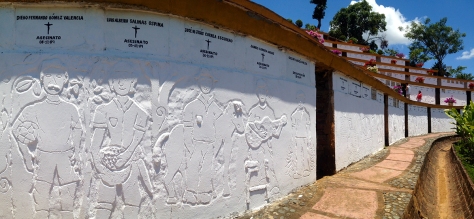The Massacre of Trujillo refers to multiple and successive human rights violations committed between 1988 and 1994 in the municipalities of Trujillo, Bolivar, and Riofrio (Valle del Cauca), including enforced disappearances, torture and the murders of approximately 340 people at the hands of a coordinated criminal structure which included members of the Army, Police, local politicians and paramilitaries from the North Valle cartel.
This systematic annihilation of the civilian population was carried out in order to secure this strategic corridor to the Pacific, where the civilian population was repeatedly accused of assisting insurgent groups present in the area.

Several known drug traffickers have been linked to the killings and taken to trial, including Henry Loaiza Ceballos, alias ‘El Alacran’, Ivan Urdinola Grajales, alias ‘El Enano’ and Diego Montoya Sanchez, alias ‘Don Diego’ currently in detention in the United States, as well as a number of members of the security forces including major (r) Urueña Jaramillo (who at the time of events was the commander of the Palace Batallion in Buga, of the Army’s Third Brigade) and Lieutenant (r) Jose Fernando Berrio (commander of Trujillo Police from 1989 to 1991).[1]
Stories from the field: Trujillo, where memories cannot be silenced
In photographs: Semillas de la memoria
In photographs: With lawyer Eduardo Carreño in Trujillo

This case was presented to the Inter-American Commission on Human Rights (IACHR) in 1992, for actions and omissions which enabled the execution of selective crimes against small-scale farmers in the region, a situation which went on to cause the displacement of the people who survived the massacre. On 6th April 2016, there was a public ceremony where the Colombian State recognised its responsibility for the deaths of 76 victims, 34 more victims than had already been recognised in 1995 by the then Colombian President Ernesto Samper, on behalf of the State.[2]
In photographs: Trujillo: The Colombian St signed a 2nd settlement agreement before the IACHR
Footnotes:
[1] CCAJAR: Fiscalía ratifica llamado a juicio al coronel (r) del Ejército Alirio Antonio Urueña Jaramillo y al teniente (r) de la Policía José Fernando Berrio por la masacre de Trujillo, 3 September 2008; Verdad Abierta: Condenan al mayor (r) Alirio Urueña por la masacre de Trujillo, 10 October 2010
[2] Vanguardia: Trujillo recuerda a sus víctimas y el Estado reconoce su responsabilidad, 23rd April 2016; El Espectador: Estado pidió perdón por la masacre de Trujillo, 23rd April 2016; CCAJAR: Estado fue responsable de masacre de Trujillo: Minjusticia, In: Prensa Rural, 2 May 2016

